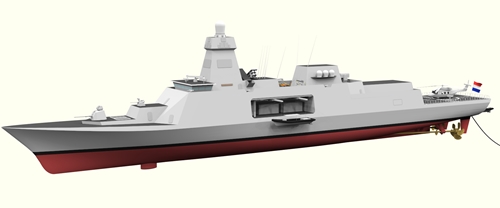Breaking news
Future Belgian Navy Frigates May Have Ballistic Missile Defense Capabilities.
| 2017
|
|
|||
| a | |||
|
Naval Forces News - Belgium
|
|||
|
|
|||
|
Future Belgian Navy Frigates May Have Ballistic Missile Defense Capabilities
|
|||
|
Belgium is planning to give Ballistic Missile Defense (BMD) capabilities to its future frigates. The information was revelead in December 2016 by Dutch online media Marineschepen, a well-connected source on Dutch and Belgian naval defence topics.
Contacted by Navy Recognition in December, a Belgian Navy spokesperson confirmed that the government had such intention, but the decision (to give the future frigates BMD capabilities) would be political. The spokesman pointed to an official document from the Belgian "Chamber of Representatives" from July 2016 in which the BMD topic was mentionned for the first time. |
|||
|
|
|||
 Computer rendering showing the early design of the M-class frigate replacement. Picture: Dutch Defence Materiel Organisation. |
|||
|
|
|||
|
In this report from the Warsaw NATO Summit, on page 6, the document mentions:
Belgium takes its share of the common costs for the Ballistic Missile Defense program. For the future, more attention needs to be focused on this system, which is increasingly seen as the third element of the Alliance's policy of deterrence and defense. Within the framework of the 2030 Strategic Vision for Belgian defense, the new frigates will be able to engage ex-atmospheric ballistic missiles and may therefore, as appropriate, also participate to a Ballistic Missile Defense system. As we reported, Belgium and the Netherlands signed an MoU on December 1st last year to replace their current Frigates with a common, new class of vessel. As Marineschepen stresses however, the Netherlands position on BMD capability is not known yet and the new Frigate project (for which the Netherlands has the lead) is still in early stages of development. |
|
|
|||
|
Example of a successful BMD intercept test with a SM-3 Block IB in June 2012
|
|||
|
|
|||
|
The German Navy announced in December that its three F124 Sachsen-class frigates will be upgraded with a new radar in order to join the NATO BMD system. These vessels would serve as sea-based sensors exclusively however.
In contrast, the Belgium parliamentary document mentions effectors: "the new frigates will be able to engage exo-atmospheric ballistic missiles". That capability would be unique for a European navy. The only missile system currently capable of engaging exo-atmospheric targets is the RIM-161 Standard Missile 3 (SM-3) by Raytheon currently operated by the US Navy and the Japan Maritime Self-Defense Force. Thanks to its Lightweight Exo-atmospheric Projectile (LEAP) it can destroy incoming ballistic missiles both inside or outside the Earth's atmosphere. Italy and France are also working on a BMD variant of the Aster 30 missile, the Aster 30 Block 1NT, but it is still in its early stages of development. Processing power is paramount for such a capability and this factor (radar sensor and combat system) is likely to have an impact as well in terms of ship design. Last but not least, the effectors and sensors to achieve BMD capability are far from affordable. It remains to be seen if the Belgian government will be able to provide the navy with the means to fund such an ambitious project. |
|||
|
|
|||
 Computer rendering of Lightweight Exo-atmospheric Projectile (LEAP). Image: Raytheon Computer rendering of Lightweight Exo-atmospheric Projectile (LEAP). Image: Raytheon |
|||


























